非谓语动词巧学
- 格式:doc
- 大小:109.00 KB
- 文档页数:72

非谓语动词总结非谓语动词是英语语法中的一种重要的句子成分,包括动词不定式、动名词和现在分词。
非谓语动词可以在句子中作主语、宾语、定语、状语等,具有丰富的用法和功能。
下面将对非谓语动词进行总结并详细介绍其用法和特点。
一、动词不定式1.基本形式:to + 动词原形。
例如:to eat, to sleep, to study, to run等。
2.作主语:a)It + be + adj. + to-infinitive。
例如:It is important to study hard.b)To-infinitive + be + 主语。
例如:To study hard is importantfor students.3.作宾语:a)动词 + to-infinitive。
例如:I like to read books.b)动词不定式作宾语补语。
例如:I find it boring to watch TV.4.作定语:被修饰的名词前加不定式。
例如:I have a book to read.5.作状语:a)表示目的:动词 + to-infinitive。
例如:I go to school to study.b)表示结果:动词 + too + adj./adv. + to-infinitive。
例如:He was too tired to run.c)表示方式:动词 + adj. + to-infinitive。
例如:She was surprised to see me.d)表示条件:动词 + v.原 + to-infinitive。
例如:I want to have a rest to be able to work tomorrow.二、动名词1.基本形式:动词原形 + -ing。
例如:eating, sleeping, studying, running等。
2.作主语:a)动名词单独作主语。
例如:Swimming is good for health.b)It + be + adj. + for + 动名词。
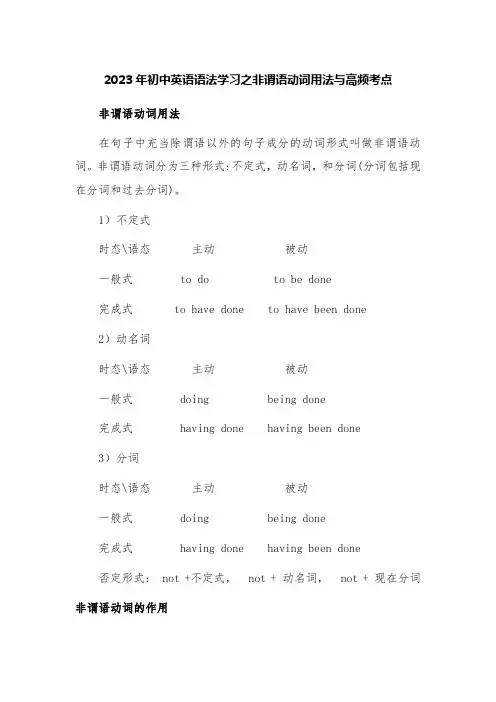
2023年初中英语语法学习之非谓语动词用法与高频考点非谓语动词用法在句子中充当除谓语以外的句子成分的动词形式叫做非谓语动词。
非谓语动词分为三种形式:不定式,动名词,和分词(分词包括现在分词和过去分词)。
1)不定式时态\语态主动被动一般式to do to be done完成式 to have done to have been done2)动名词时态\语态主动被动一般式doing being done完成式having done having been done3)分词时态\语态主动被动一般式doing being done完成式having done having been done否定形式: not +不定式,not + 动名词,not + 现在分词非谓语动词的作用非谓语动词除去不能做谓语之外,其它所有成分都可以做。
具体如下。
1. 不定式:做主语、宾语、表语、定语、状语和补语。
To learn a foreign language is difficult .(作主语)学会一门外语是很难的。
It’s easy to see their aunt.(作真正主语,it做形式主语)很容易见到他们的姑姑。
Tom wanted to have a cup of beer.(作宾语)汤姆想要喝杯啤酒。
His wish is to be a driver.(作表语)他的愿望是当一名司机。
I have nothing to say.(作定语)我没有什么可说的。
The teacher told us to do morning exercises . (作宾语补足语)老师让我们做早操。
They went to see their aunt. (目的状语)他们去见他们的姑姑。
2. 动名词:做主语、宾语、表语、定语和补语。
Learning English is very difficult .(作主语)学英语非常困难。
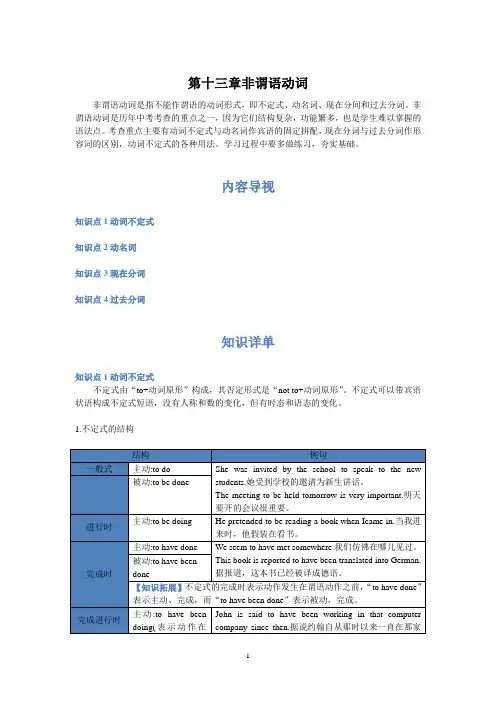
第十三章非谓语动词非谓语动词是指不能作谓语的动词形式,即不定式、动名词、现在分间和过去分词。
非谓语动词是历年中考考查的重点之一,因为它们结构复杂,功能繁多,也是学生难以掌握的语法点。
考查重点主要有动词不定式与动名词作宾语的固定拼配,现在分词与过去分词作形容词的区别,动词不定式的各种用法。
学习过程中要多做练习,夯实基础。
内容导视知识点1动词不定式知识点2动名词知识点3现在分词知识点4过去分词知识详单知识点1动词不定式不定式由“to+动词原形”构成,其否定形式是“not to+动词原形”。
不定式可以带宾语状语构成不定式短语,没有人称和数的变化,但有时态和语态的变化。
1.不定式的结构结构例句一般式主动:to do She was invited by the school to speak to the newstudents.她受到学校的邀请为新生讲话。
The meeting to be held tomorrow is very important.明天要开的会议很重要。
被动:to be done进行时主动:to be doing He pretended to be reading a book when Icame in.当我进来时,他假装在看书。
完成时主动:to have done We seem to have met somewhere.我们仿佛在哪儿见过。
This book is reported to have been translated into German.据报道,这本书已经被译成德语。
被动:to have beendone【知识拓展】不定式的完成时表示动作发生在谓语动作之前,“to have done”表示主动、完成,而“to have been done”表示被动,完成。
完成进行时主动:to have beendoing(表示动作在John is said to have been working in that computercompany since then.据说约翰自从那时以来一直在那家谓语动作发生之前一直在进行)电脑公司工作。

非谓语动词总结知识点一、动词不定式(Infinitive)动词不定式由“to + 动词原形”构成。
动词不定式在句子中可以作多种成分,具有名词的性质。
下面是动词不定式的主要用法:1. 作主语:To travel around the world is my dream.2. 作宾语:I want to study English.3. 作定语:The best way to learn English is to practice speaking.4. 作表语:My goal is to improve my English.5. 作状语:He goes to the library to study every day.当动词不定式作为宾语补足语时,它可以由动词原形构成(Bare Infinitive)。
例如:I saw him draw a picture yesterday. (我昨天看到他画了一幅画。
)二、动名词(Gerund)动名词是由动词的现在分词形式加上动词-ing构成的。
动名词在句子中可以作多种成分,具有名词的性质。
下面是动名词的主要用法:1. 作主语:Reading is my hobby.2. 作宾语:I enjoy swimming in the ocean.3. 作定语:I like watching movies.4. 作表语:His favorite activity is playing basketball.5. 作状语:He left without saying goodbye.动名词与不定式的区别在于,动名词具有名词的性质,而动词不定式具有动词的性质。
例如:I like swimming. (我喜欢游泳。
)I like to swim. (我喜欢游泳。
)动名词与动词不定式作宾语时,有时可以根据动词选择使用不定式还是动名词。
例如:I stopped smoking. (我戒烟了。
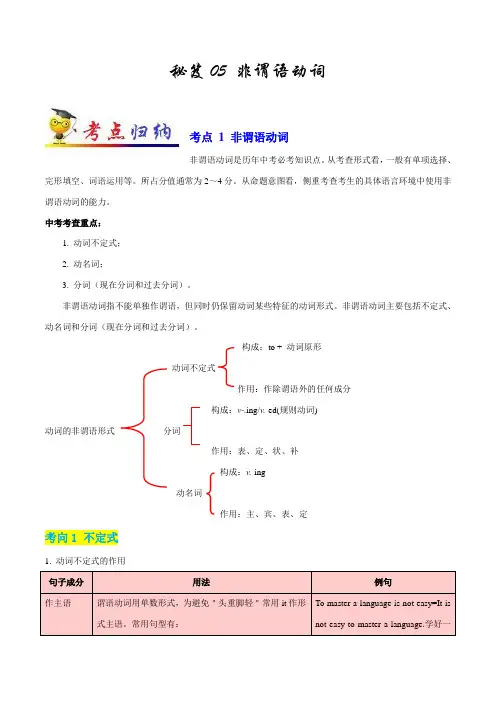
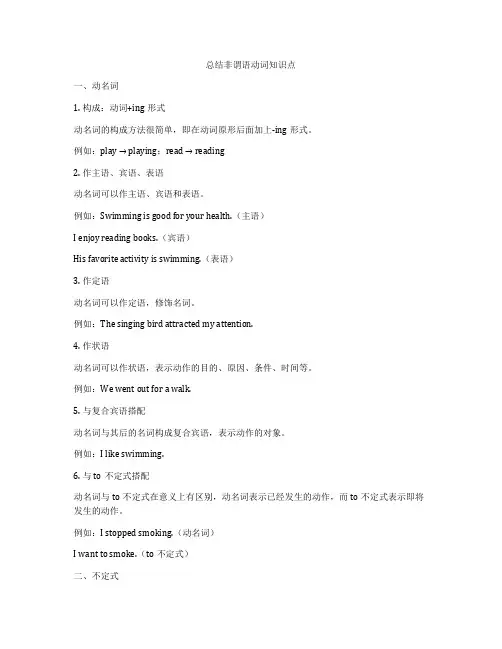
总结非谓语动词知识点一、动名词1. 构成:动词+ing形式动名词的构成方法很简单,即在动词原形后面加上-ing形式。
例如:play → playing;read → reading2. 作主语、宾语、表语动名词可以作主语、宾语和表语。
例如:Swimming is good for your health.(主语)I enjoy reading books.(宾语)His favorite activity is swimming.(表语)3. 作定语动名词可以作定语,修饰名词。
例如:The singing bird attracted my attention.4. 作状语动名词可以作状语,表示动作的目的、原因、条件、时间等。
例如:We went out for a walk.5. 与复合宾语搭配动名词与其后的名词构成复合宾语,表示动作的对象。
例如:I like swimming.6. 与to不定式搭配动名词与to不定式在意义上有区别,动名词表示已经发生的动作,而to不定式表示即将发生的动作。
例如:I stopped smoking.(动名词)I want to smoke.(to不定式)二、不定式1. 构成:to+动词原形不定式的构成方法很简单,即在动词原形前加上to。
例如:go → to go;study → to study2. 作主语、宾语、表语不定式可以作主语、宾语和表语。
例如:To learn English well is important.(主语)I want to study abroad.(宾语)His dream is to become a doctor.(表语)3. 作定语不定式可以作定语,修饰名词。
例如:She gave me some books to read.4. 作状语不定式可以作状语,表示目的、原因、条件等。
例如:I went to the library to borrow some books.5. 与动名词搭配不定式与动名词在意义和用法上有区别,不定式表示即将发生的动作,而动名词表示已经发生的动作。
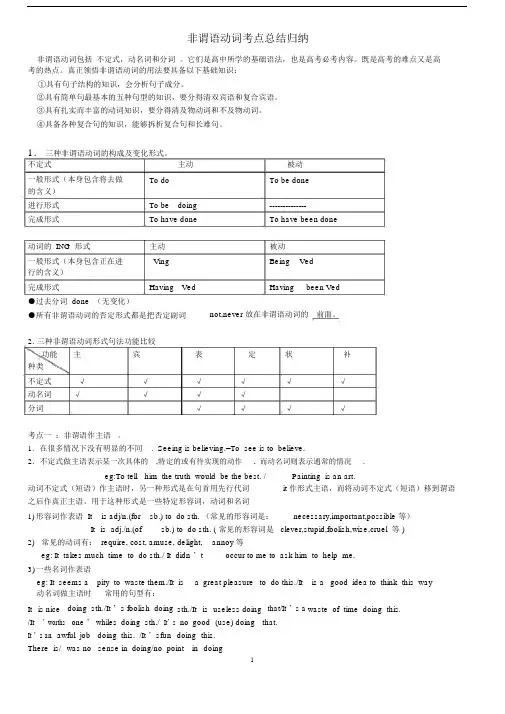
非谓语动词考点总结归纳非谓语动词包括不定式,动名词和分词。
它们是高中所学的基础语法,也是高考必考内容。
既是高考的难点又是高考的热点。
真正领悟非谓语动词的用法要具备以下基础知识:①具有句子结构的知识,会分析句子成分。
②具有简单句最基本的五种句型的知识,要分得清双宾语和复合宾语。
③具有扎实而丰富的动词知识,要分得清及物动词和不及物动词。
④具备各种复合句的知识,能够拆析复合句和长难句。
1.三种非谓语动词的构成及变化形式。
不定式主动被动一般形式(本身包含将去做To do To be done的含义)进行形式To be doing--------------完成形式To have done To have been done动词的 ING 形式主动被动一般形式(本身包含正在进Ving Being Ved行的含义)完成形式Having Ved Having been Ved●过去分词 done (无变化)●所有非谓语动词的否定形式都是把否定副词not,never 放在非谓语动词的前面。
2.三种非谓语动词形式句法功能比较功能主宾表定状补种类不定式√√√√√√动名词√√√√分词√√√√考点一:非谓语作主语。
1.在很多情况下没有明显的不同 . Seeing is believing.=To see is to believe.2.不定式做主语表示某一次具体的,特定的或有待实现的动作,而动名词则表示通常的情况.eg:To tell him the truth would be the best. /Painting is an art.动词不定式(短语)作主语时,另一种形式是在句首用先行代词it 作形式主语,而将动词不定式(短语)移到谓语之后作真正主语。
用于这种形式是一些特定形容词,动词和名词1)形容词作表语 It is adj/n.(for sb.) to do sth. (常见的形容词是:necessary,important,possible 等)It is adj./n.(of sb.) to do sth. ( 常见的形容词是 clever,stupid,foolish,wise,cruel 等 )2)常见的动词有: require, cost, amuse, delight,annoy 等eg: It takes much time to do sth./ It didn ’t occur to me to ask him to help me.3)一些名词作表语eg: It seems a pity to waste them./It is a great pleasure to do this./It is a good idea to think this way动名词做主语时常用的句型有:It is nice doing sth./It ’s foolish doing sth./It is useless doing that/It ’s a waste of time doing this./It’worths one ’ whiles doing sth./It’s no good(use) doing that.It ’s an awful job doing this. /It ’s f un doing this.There is/was no sense in doing/no point in doing1考点二:非作5+3P70-72充 :1.begin 和 start 在下列三种情况下 ,通常跟不定式 , 不跟名1)当 begin 和 start 的主是无生命之物 .eg: Snow began to melt.2)当 begin 和 start 用于行 .eg: He is beginning to study English.3)当 begin 和 start 后面跟着一些表示心理状的. eg: I began to believe his story.2.be afraid to do 不敢去做⋯⋯be afraid of doing 害怕生某事3.be sure to do 一定会⋯⋯be sure of doing 确信会⋯⋯eg: Tom is sure to pass the exam.(人的看法 ,Tom 一定会考通.)Tom is sure of passing the exam. ( Tom 自己通考很有把握.)考点三:非作表不定式、名、分做表:1. 不定式做表常表示所表示作之后生的作。
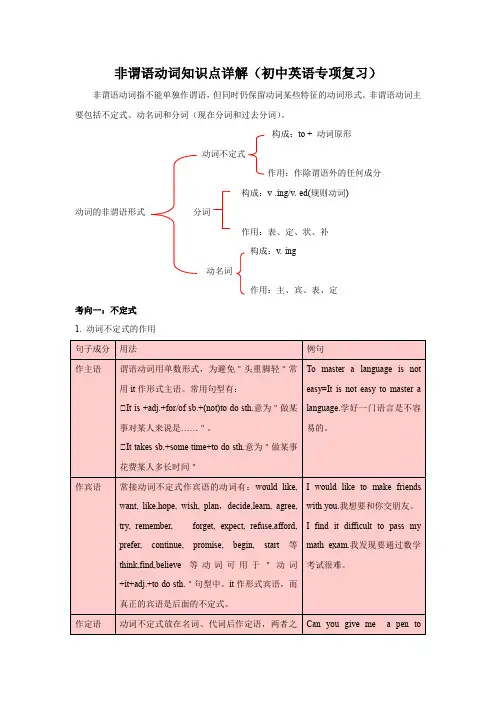
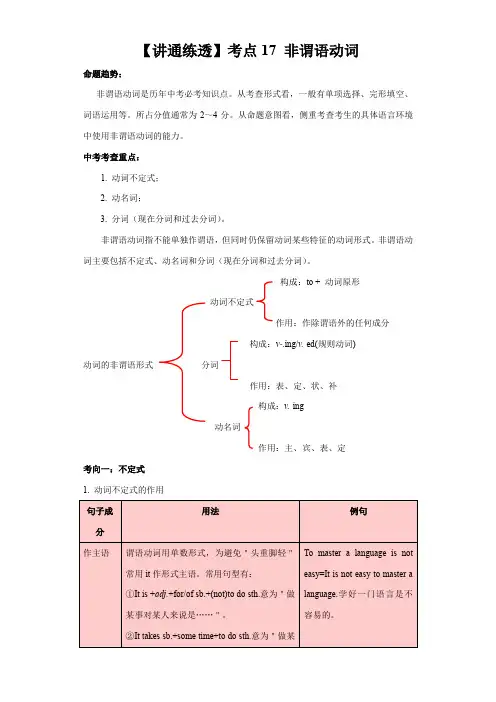
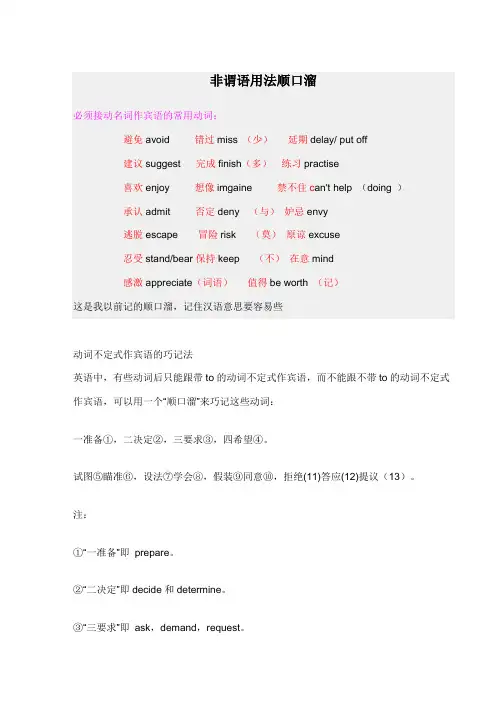
非谓语用法顺口溜必须接动名词作宾语的常用动词:避免avoid 错过miss (少)延期delay/ put off建议suggest 完成finish(多)练习practise喜欢enjoy 想像imgaine 禁不住c an't help (doing )承认admit 否定deny (与)妒忌envy逃脱escape 冒险risk (莫)原谅excuse忍受stand/bear保持keep (不)在意mind感激appreciate(词语)值得be worth (记)这是我以前记的顺口溜,记住汉语意思要容易些动词不定式作宾语的巧记法英语中,有些动词后只能跟带to的动词不定式作宾语,而不能跟不带to的动词不定式作宾语,可以用一个“顺口溜”来巧记这些动词:一准备①,二决定②,三要求③,四希望④。
试图⑤瞄准⑥,设法⑦学会⑧,假装⑨同意⑩,拒绝(11)答应(12)提议(13)。
注:①“一准备”即prepare。
②“二决定”即decide和determine。
③“三要求”即ask,demand,request。
④“四希望”即desire期望,expect盼望,hope希望,wish愿望。
⑤“试图”即attempt。
⑥“瞄准”即aim。
⑦“设法”即manage。
⑧“学会”即learn。
⑨“假装”即pretend。
⑩“同意”即agree。
(11) “拒绝”即refuse。
(12)“答应”即promise。
(13)“提议”即offer。
必须接不定式作宾语的常用动词:“一二三四”心里记,(①“一准备”即prepare。
②“二决定”即decide和determine。
③“三要求”即ask,demand,request。
④“四希望”即desire期望,expect盼望,hope 希望,wish愿望。
)假装拒绝不同意。
( pretend refuse agree)试图瞄准设法学,(attempt aim manage learn)答应提议不定式。
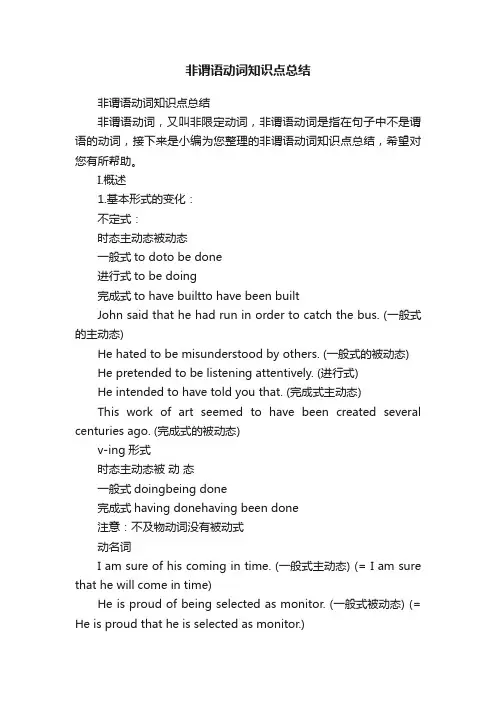
非谓语动词知识点总结非谓语动词知识点总结非谓语动词,又叫非限定动词,非谓语动词是指在句子中不是谓语的动词,接下来是小编为您整理的非谓语动词知识点总结,希望对您有所帮助。
I.概述1.基本形式的变化:不定式:时态主动态被动态一般式to doto be done进行式to be doing完成式to have builtto have been builtJohn said that he had run in order to catch the bus. (一般式的主动态)He hated to be misunderstood by others. (一般式的被动态) He pretended to be listening attentively. (进行式)He intended to have told you that. (完成式主动态)This work of art seemed to have been created several centuries ago. (完成式的被动态)v-ing形式时态主动态被动态一般式doingbeing done完成式having donehaving been done注意:不及物动词没有被动式动名词I am sure of his coming in time. (一般式主动态) (= I am sure that he will come in time)He is proud of being selected as monitor. (一般式被动态) (= He is proud that he is selected as monitor.)I’m confident of his having passed the exam. (完成式主动态) (= I am confident that he have passed the exam.)He complained of having been cheated by others. (完成式被动态)现在分词He sat in a chair,reading a novel. (一般式主动态)Being exhausted by work, he fell asleep quickly. (一般式被动态)Having finished his homework, he went playing. (完成式主动态)All this having been settled, he went home. (完成式被动态)2.所做成分项目/成分主语表语宾语宾补定语状语动词的ing形式现在分词△ △△△动名词△△△ △不定式△△△△△△过去分词△ △△△注:现在分词、不定式、过去分词都可以作独立成分。
1 非谓语动词巧学
一、非谓语动词种类及句法功能: (一)概述: 在英语中,有动词特点,却不作句子谓语,有除谓语外其他语法功能的动词,叫做非谓语动词。非谓语动词有动词不定式(the Infinitive);动名词(the Gerund);分词(the Participles)即:现在分词(the Present Participle) 2
和过去分词(the Past Participle)。 1、非谓语动词与谓语动词的相同点有: 1)如果是及物动词都可与宾语连用,例如: They built a garden. They suggested building a garden. 2)都可以被状语修饰: The suit fits him very well. 3
The suit used to fit him very well. 3)都有主动与被动, “体”式(一般式;进行式;完成式)的变化。例如: He was punished by his parents.(谓语动词被动语态) He avoided being punished by his parents.(动名词的被动式) We have written the composition.(谓语动词的完成时) 4
Having written the composition, we handed it in.(现在分词的完成式) 4)都可以有逻辑主语 They started the work at once.(谓语动词的逻辑主语) The boss ordered them to start the work.(动词不定式的逻辑主语) We are League members.(谓语动词的主语) 5
We being League member, the work was well done.(现在分词的逻辑主语) 2、非谓语动词与谓语动词的不同点有: 1)非谓语动词可以有名词作用(如动词不定式和动名词),在句中做主语、宾语、表语。 2)非谓语动词可以有形容词作用(如动词不定式和分词),在句中做定语、表语或宾语补足语。 6
3)非谓语动词可以有副词作用(如动词不定式和分词),在句中作状语。 (二)非谓语动词的句法功能: 句子成分 非谓语 主语 表语 宾语 补语 定语 状语 同位语
不定式 ü ü ü ü ü ü ü 动名词 ü ü ü (极少) ü ü 7
现在分词 ü ü ü ü 过去分词 ü ü ü ü 二、非谓语动词用法: (一)动词不定式: 动词不定式基本用法口诀 不定式有标记,to与动原连一起。 没有人称数变化,动词特点它具备。 主宾定补表状语,惟独作谓不可以。 8
not加上不定式,否定结构要牢记。 疑问词与不定式,构成短语有意义。 仔细推敲多思考,准确判断有依据。 1、不定式的表现形式: (to)+do,具有名词、形容词、副词的特征。
主 动 被 动 一般式 to write to be written 9
进行式 to be writing / 完成式 to have written to have been written
否定式:not + (to) do 1)一般式:不定式的一般式所表示的动作与谓语动词动作同时发生或发生在谓语动词动作之后,例如: I’m glad to meet you. 10
He seems to know a lot. We plan to pay a visit. He wants to be an artist. The patient asked to be operated on at once. The teacher ordered the work to be done. 2)进行式:不定式的进行式表示谓语动词动作发生时,不定式动作正在发生。例如: 11
The boy pretended to be working hard. He seems to be reading in his room. 3)完成式:不定式的完成式表示的动作先于谓语动词动作发生,例如: I regretted to have told a lie. I happened to have seen the film. He is pleased to have met his friend. 2、不定式的句法功能: 12
1)作主语,谓语要用第三人称单数。 To finish the work in ten minutes is very hard. To lose your heart means failure. 动词不定式短语作主语时,常用形式主语it作形式主语,例如上面两句可用如下形式: It is very hard to finish the work in ten minutes. 13
It means failure to lose your heart. 如果要说明不定式动作的执行者,可以在不定式前假一个for引起的短语: It is not hard for one to do a bit of good. It is a great honour for us to be present at this rally. 2)作表语:对主语进行解释和说明。 Her job is to clean the hall. 14
He appears to have caught a cold. 3)作宾语: 巧记接不定式作宾语的动词: 三个希望两答应(Hope, wish, want, agree, promise) 两个要求莫拒绝(Demand, ask, refuse ) 设法学会做决定(Manage, learn, decide ) 不要假装在选择(Pretend, choose ) She promised to return in a hour. 15
When the teacher came in, he pretended to be reading a book. 如果不定式(宾语)后面有宾语补足语,则用it作形式宾语,真正的宾语(不定式)后置,放在宾语补足语后面,例如: Marx found it important to study the situation in Russia. 动词不定式也可充当介词宾语,如: 16
I have no choice but to stay here. He did nothing last Sunday but repair his bike. 动词不定式前有时可与疑问词连用,在句中可作主语、宾语、表语,如: When to start hasn’t been decided. I don’t know what to do next . He gave us some advice on how to learn English. 17
The question is how to begin. 接疑问词加to do 作宾语的常见常见动词可记如下顺口溜: 学会忘记是有难处,(learn,forget) 想知道就别来劝阻。(wonder,know,advise) 展开讨论教人对付,(show, discuss,teach) 弄清楚才决定告诉。(find out,decide,tell) 4)作宾语补足语: 18
要求跟不定式作宾补的动词有: (1)劝教命请叫(advise,teach,order, command,ask,tell) (2)允许又警告(allow,permit,warn) (3)使役表意向(cause,let,have,make,lead, set,leave,get,wish,want,expect) (4)知觉动词妙(feel,hear,watch,see, observe,notice)